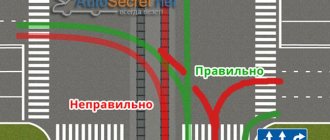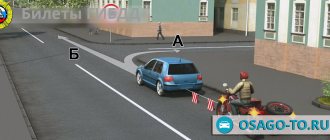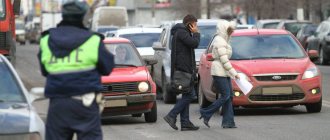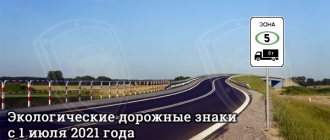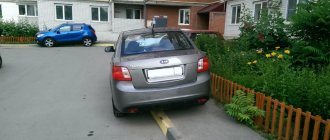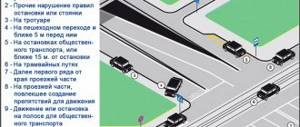Sign 8.9.1 - Parking for parking permit holders only
Sign 8.9.1 - Parking for parking permit holders only belongs to the category: Additional information signs (plates) in accordance with the traffic rules for 2019.
Traffic rules 2021 additional information signs (plates) serve to clarify, supplement or limit the validity of those traffic rules signs with which they are used. Also, additional information signs may contain other information for the driver. This category represents a fairly large number of different signs with different meanings, so you should study it more carefully. The main function of additional information signs is to clarify the main signs, such as the length of the zone in which the prohibition on stopping a vehicle or the method of stopping it applies.
Additional information signs also include photo and video recording, which is used with many prohibitory and mandatory signs, the environmental class of the vehicle, the operation of a tow truck, etc. Additional information signs are located directly below the sign with which they are used. In cases where signs are located above a sidewalk or roadway, they are located to the side of the sign. Also, in cases where the information on temporary signs and permanent ones contradicts each other, drivers should be guided by temporary additional information signs, which are shown on a yellow background.
Other organizations
Sign 8.24 - Tow Truck Operating
Indicates that a vehicle is being detained in the coverage area of road signs 3.27 - 3.30.
Sign 8.23 - Photo and video recording
Applicable with signs 1.1, 1.2, 1.8, 1.22, 3.1 - 3.7, 3.18.1, 3.18.2, 3.19, 3.20, 3.22, 3.24, 3.27 - 3.30, 5.14, 5.21, 5.27 and 5.31 , as well as with traffic lights. Indicates that in the coverage area of a road sign or on a given section of the road, administrative offenses can be recorded using automatic special technical means that have the functions of photography, filming and video recording, or by means of photography, filming and video recording.
Sign 8.22.3 - Obstacle
They indicate the obstacle and the direction to avoid it. Used with signs 4.2.1 - 4.2.3.
Sign 8.22.2 - Obstacle
They indicate the obstacle and the direction to avoid it. Used with signs 4.2.1 - 4.2.3.
Sign 8.22.1 - Obstacle
They indicate the obstacle and the direction to avoid it. Used with signs 4.2.1 - 4.2.3.
Sign 8.21.3 - Type of route vehicle
Used with sign 6.4. They indicate where vehicles are parked at metro stations, bus (trolleybus) or tram stops, where transfer to the appropriate mode of transport is possible.
Sign 8.21.2 - Type of route vehicle
Used with sign 6.4. They indicate where vehicles are parked at metro stations, bus (trolleybus) or tram stops, where transfer to the appropriate mode of transport is possible.
Sign 8.21.1 - Type of route vehicle
Used with sign 6.4. They indicate where vehicles are parked at metro stations, bus (trolleybus) or tram stops, where transfer to the appropriate mode of transport is possible.
Sign 8.20.2 - Type of vehicle bogie
Used with sign 3.12. Indicate the number of adjacent axles of the vehicle, for each of which the mass indicated on the sign is the maximum permissible.
Sign 8.20.1 - Type of vehicle bogie
Used with sign 3.12. Indicate the number of adjacent axles of the vehicle, for each of which the mass indicated on the sign is the maximum permissible.
Sign 8.19 - Class of dangerous goods
Indicates the number of the class (classes) of dangerous goods according to GOST 19433-88.
Sign 8.18 - Except for disabled people
Indicates that the sign does not apply to motorized wheelchairs and cars on which the “Disabled” identification sign is installed.
Sign 8.17 - Disabled people
Indicates that the effect of sign 6.4 applies only to motorized wheelchairs and cars on which the “Disabled” identification sign is installed.
Sign 8.16 - Wet surface
Indicates that the sign applies to the period of time when the roadway surface is wet.
Sign 8.15 - Blind pedestrians
Indicates that the pedestrian crossing is used by the blind. Used with signs 1.22, 5.19.1, 5.19.2 and traffic lights.
Sign 8.14 - Traffic lane
Indicates the traffic lane or bicycle lane covered by a sign or traffic light.
Sign 8.13 - Direction of the main road
Indicates the direction of the main road at an intersection.
Sign 8.12 - Dangerous shoulder
Warns that going to the side of the road is dangerous due to repair work being carried out on it. Used with sign 1.25.
Sign 8.11 - Maximum weight limit
Indicates that the sign applies only to vehicles with a permissible maximum weight exceeding the maximum weight indicated on the plate.
Sign 8.10 - Vehicle inspection area
Indicates that on the site marked with sign 6.4 or 7.11 there is an overpass or inspection ditch.
Sign 8.9.1 - Parking for parking permit holders only
Indicates that only vehicles whose owners have a parking permit, obtained in accordance with the procedure established by the executive authorities of a constituent entity of the Russian Federation or local self-government bodies and valid within the territory whose boundaries are established by the relevant executive authorities, can be placed in a parking lot marked with sign 6.4. subject of the Russian Federation or local government bodies.
Sign 8.9 - Limitation of parking duration
Indicates the maximum duration of a vehicle's stay in a parking lot marked with sign 6.4.
Sign 8.8 - Paid services
Indicates that services are provided for a fee only.
Sign 8.7 - Parking with the engine not running
Indicates that in a parking lot marked with sign 6.4, parking of vehicles only with the engine not running is permitted.
Sign 8.6.9 - Method of parking a vehicle
Plaque 8.6.1 indicates that all vehicles must be parked parallel to the edge of the roadway. Plates 8.6.2 - 8.6.9 indicate the method of parking cars and motorcycles in sidewalk parking.
Sign 8.6.8 - Method of parking a vehicle
Plaque 8.6.1 indicates that all vehicles must be parked parallel to the edge of the roadway. Plates 8.6.2 - 8.6.9 indicate the method of parking cars and motorcycles in sidewalk parking.
Sign 8.6.7 - Method of parking a vehicle
Plaque 8.6.1 indicates that all vehicles must be parked parallel to the edge of the roadway. Plates 8.6.2 - 8.6.9 indicate the method of parking cars and motorcycles in sidewalk parking.
Sign 8.6.6 - Method of parking a vehicle
Plaque 8.6.1 indicates that all vehicles must be parked parallel to the edge of the roadway. Plates 8.6.2 - 8.6.9 indicate the method of parking cars and motorcycles in sidewalk parking.
Sign 8.6.5 - Method of parking a vehicle
Plaque 8.6.1 indicates that all vehicles must be parked parallel to the edge of the roadway. Plates 8.6.2 - 8.6.9 indicate the method of parking cars and motorcycles in sidewalk parking.
Sign 8.6.4 - Method of parking a vehicle
Plaque 8.6.1 indicates that all vehicles must be parked parallel to the edge of the roadway. Plates 8.6.2 - 8.6.9 indicate the method of parking cars and motorcycles in sidewalk parking.
Sign 8.6.3 - Method of parking a vehicle
Plaque 8.6.1 indicates that all vehicles must be parked parallel to the edge of the roadway. Plates 8.6.2 - 8.6.9 indicate the method of parking cars and motorcycles in sidewalk parking.
Sign 8.6.2 - Method of parking a vehicle
Plaque 8.6.1 indicates that all vehicles must be parked parallel to the edge of the roadway. Plates 8.6.2 - 8.6.9 indicate the method of parking cars and motorcycles in sidewalk parking.
Sign 8.6.1 - Method of parking a vehicle
Plaque 8.6.1 indicates that all vehicles must be parked parallel to the edge of the roadway. Plates 8.6.2 - 8.6.9 indicate the method of parking cars and motorcycles in sidewalk parking.
Sign 8.5.7 - Time of validity
Indicate the days of the week and time of day during which the sign is valid.
Sign 8.5.6 - Action time
Indicate the days of the week and time of day during which the sign is valid.
Sign 8.5.5 - Time of validity
Indicate the days of the week and time of day during which the sign is valid.
Sign 8.5.4 - Action time
Indicates the time of day during which the sign is valid.
Sign 8.5.3 - Days of the week
Indicate the days of the week during which the sign is valid.
Sign 8.5.2 - Working days
Indicate the days of the week during which the sign is valid.
Sign 8.5.1 - Saturdays, Sundays and holidays
Indicate the days of the week during which the sign is valid.
Sign 8.4.15 -
Indicate the type of vehicle that is not covered by the sign. Plate 8.4.14 does not apply the sign to vehicles used as a passenger taxi.
Sign 8.4.14 - Except for the type of vehicle
Indicate the type of vehicle that is not covered by the sign. Plate 8.4.14 does not apply the sign to vehicles used as a passenger taxi.
Sign 8.4.13 - Except for the type of vehicle
Indicate the type of vehicle that is not covered by the sign. Plate 8.4.14 does not apply the sign to vehicles used as a passenger taxi.
Sign 8.4.12 - Except for the type of vehicle
Indicate the type of vehicle that is not covered by the sign. Plate 8.4.14 does not apply the sign to vehicles used as a passenger taxi.
Sign 8.4.11 - Except for the type of vehicle
Indicate the type of vehicle that is not covered by the sign. Plate 8.4.14 does not apply the sign to vehicles used as a passenger taxi.
Sign 8.4.10 - Except for the type of vehicle
Indicate the type of vehicle that is not covered by the sign. Plate 8.4.14 does not apply the sign to vehicles used as a passenger taxi.
Sign 8.4.9 - Except for the type of vehicle
Indicate the type of vehicle that is not covered by the sign. Plate 8.4.14 does not apply the sign to vehicles used as a passenger taxi.
Sign 8.4.8 - Type of vehicle
Indicate the type of vehicle to which the sign applies. Plate 8.4.1 applies the sign to trucks, including trailers, with a permissible maximum weight of more than 3.5 tons; Plate 8.4.3 - to passenger cars, as well as trucks vehicles with a permissible maximum weight of up to 3.5 tons; Plate 8.4.3.1 - for electric vehicles and hybrid vehicles that can be charged from an external source; Plate 8.4.8 - for vehicles equipped with identification signs (information plates) “Dangerous cargo”.
Sign 8.4.7 - Type of vehicle
Indicate the type of vehicle to which the sign applies. Plate 8.4.1 applies the sign to trucks, including trailers, with a permissible maximum weight of more than 3.5 tons; Plate 8.4.3 - to passenger cars, as well as trucks vehicles with a permissible maximum weight of up to 3.5 tons; Plate 8.4.3.1 - for electric vehicles and hybrid vehicles that can be charged from an external source; Plate 8.4.8 - for vehicles equipped with identification signs (information plates) “Dangerous cargo”.
Sign 8.4.6 - Type of vehicle
Indicate the type of vehicle to which the sign applies. Plate 8.4.1 applies the sign to trucks, including trailers, with a permissible maximum weight of more than 3.5 tons; Plate 8.4.3 - to passenger cars, as well as trucks vehicles with a permissible maximum weight of up to 3.5 tons; Plate 8.4.3.1 - for electric vehicles and hybrid vehicles that can be charged from an external source; Plate 8.4.8 - for vehicles equipped with identification signs (information plates) “Dangerous cargo”.
Sign 8.4.5 - Type of vehicle
Indicate the type of vehicle to which the sign applies. Plate 8.4.1 applies the sign to trucks, including trailers, with a permissible maximum weight of more than 3.5 tons; Plate 8.4.3 - to passenger cars, as well as trucks vehicles with a permissible maximum weight of up to 3.5 tons; Plate 8.4.3.1 - for electric vehicles and hybrid vehicles that can be charged from an external source; Plate 8.4.8 - for vehicles equipped with identification signs (information plates) “Dangerous cargo”.
Sign 8.4.4 - Type of vehicle
Indicate the type of vehicle to which the sign applies. Plate 8.4.1 applies the sign to trucks, including trailers, with a permissible maximum weight of more than 3.5 tons; Plate 8.4.3 - to passenger cars, as well as trucks vehicles with a permissible maximum weight of up to 3.5 tons; Plate 8.4.3.1 - for electric vehicles and hybrid vehicles that can be charged from an external source; Plate 8.4.8 - for vehicles equipped with identification signs (information plates) “Dangerous cargo”.
Sign 8.4.3.1 -
Indicate the type of vehicle to which the sign applies. Plate 8.4.1 applies the sign to trucks, including trailers, with a permissible maximum weight of more than 3.5 tons; Plate 8.4.3 - to passenger cars, as well as trucks vehicles with a permissible maximum weight of up to 3.5 tons; Plate 8.4.3.1 - for electric vehicles and hybrid vehicles that can be charged from an external source; Plate 8.4.8 - for vehicles equipped with identification signs (information plates) “Dangerous cargo”.
Sign 8.4.3 - Type of vehicle
Indicate the type of vehicle to which the sign applies. Plate 8.4.1 applies the sign to trucks, including trailers, with a permissible maximum weight of more than 3.5 tons; Plate 8.4.3 - to passenger cars, as well as trucks vehicles with a permissible maximum weight of up to 3.5 tons; Plate 8.4.3.1 - for electric vehicles and hybrid vehicles that can be charged from an external source; Plate 8.4.8 - for vehicles equipped with identification signs (information plates) “Dangerous cargo”.
Sign 8.4.2 - Type of vehicle
Indicate the type of vehicle to which the sign applies. Plate 8.4.1 applies the sign to trucks, including trailers, with a permissible maximum weight of more than 3.5 tons; Plate 8.4.3 - to passenger cars, as well as trucks vehicles with a permissible maximum weight of up to 3.5 tons; Plate 8.4.3.1 - for electric vehicles and hybrid vehicles that can be charged from an external source; Plate 8.4.8 - for vehicles equipped with identification signs (information plates) “Dangerous cargo”.
Sign 8.4.1 - Type of vehicle
Indicate the type of vehicle to which the sign applies. Plate 8.4.1 applies the sign to trucks, including trailers, with a permissible maximum weight of more than 3.5 tons; Plate 8.4.3 - to passenger cars, as well as trucks vehicles with a permissible maximum weight of up to 3.5 tons; Plate 8.4.3.1 - for electric vehicles and hybrid vehicles that can be charged from an external source; Plate 8.4.8 - for vehicles equipped with identification signs (information plates) “Dangerous cargo”.
Sign 8.3.3 - Directions of action
Indicate the direction of action of signs installed in front of the intersection, or the direction of movement to designated objects located directly next to the road.
Sign 8.3.2 - Directions of action
Indicate the direction of action of signs installed in front of the intersection, or the direction of movement to designated objects located directly next to the road.
Sign 8.3.1 - Directions of action
Indicate the direction of action of signs installed in front of the intersection, or the direction of movement to designated objects located directly next to the road.
Sign 8.2.6 - Coverage area
8.2.2 indicates the coverage area of prohibitory signs 3.27 - 3.30.8.2.3 indicates the end of the coverage area of the signs 3.27 - 3.30.8.2.4 informs drivers that they are in the coverage area of the signs 3.27 - 3.30.8.2.5, 8.2.6 indicates the direction and the coverage area of signs is 3.27 - 3.30 when stopping or parking is prohibited along one side of the square, the facade of a building, etc.
Sign 8.2.5 - Coverage area
8.2.2 indicates the coverage area of prohibitory signs 3.27 - 3.30.8.2.3 indicates the end of the coverage area of the signs 3.27 - 3.30.8.2.4 informs drivers that they are in the coverage area of the signs 3.27 - 3.30.8.2.5, 8.2.6 indicates the direction and the coverage area of signs is 3.27 - 3.30 when stopping or parking is prohibited along one side of the square, the facade of a building, etc.
Sign 8.2.4 - Coverage area
8.2.2 indicates the coverage area of prohibitory signs 3.27 - 3.30.8.2.3 indicates the end of the coverage area of the signs 3.27 - 3.30.8.2.4 informs drivers that they are in the coverage area of the signs 3.27 - 3.30.8.2.5, 8.2.6 indicates the direction and the coverage area of signs is 3.27 - 3.30 when stopping or parking is prohibited along one side of the square, the facade of a building, etc.
Sign 8.2.3 - Coverage area
8.2.2 indicates the coverage area of prohibitory signs 3.27 - 3.30.8.2.3 indicates the end of the coverage area of the signs 3.27 - 3.30.8.2.4 informs drivers that they are in the coverage area of the signs 3.27 - 3.30.8.2.5, 8.2.6 indicates the direction and the coverage area of signs is 3.27 - 3.30 when stopping or parking is prohibited along one side of the square, the facade of a building, etc.
Sign 8.2.2 - Coverage area
8.2.2 indicates the coverage area of prohibitory signs 3.27 - 3.30.8.2.3 indicates the end of the coverage area of the signs 3.27 - 3.30.8.2.4 informs drivers that they are in the coverage area of the signs 3.27 - 3.30.8.2.5, 8.2.6 indicates the direction and the coverage area of signs is 3.27 - 3.30 when stopping or parking is prohibited along one side of the square, the facade of a building, etc.
Sign 8.2.1 - Coverage area
Indicates the length of a dangerous section of the road, indicated by warning signs, or the coverage area of prohibitory signs, as well as signs 5.16, 6.2 and 6.4.
Sign 8.1.4 - Distance to object
Indicate the distance to an object located away from the road.
Sign 8.1.3 - Distance to object
Indicate the distance to an object located away from the road.
Sign 8.1.2 - Distance to object
Indicates the distance from sign 2.4 to the intersection if sign 2.5 is installed immediately before the intersection.
Sign 8.1.1 - Distance to object
Indicates the distance from the sign to the beginning of the dangerous section, the place where the corresponding restriction is introduced, or a specific object (place) located ahead in the direction of travel.
Sign 7.21 - Gas station with the ability to charge electric vehicles
Sign 7.20 - Fire extinguisher
Indicates the location of the fire extinguisher.
Sign 7.19 - Emergency telephone
Indicates the location where the telephone for calling emergency services is located.
Sign 7.18 - Toilet
Sign 7.17 - Pool or beach
Sign 7.16 - Radio communication area with emergency services
A section of road on which a radio communication system with emergency services operates in the civilian 27 MHz band.
Sign 7.15 - Reception area of a radio station transmitting traffic information
A section of road where radio station broadcasts are received at the frequency indicated on the sign.
Sign 7.14 - International road transport control point
Sign 7.13 - Police
Sign 7.12 - Road patrol post
Sign 7.11 - Rest Place
Sign 7.10 - Camping
Sign 7.9 - Hotel or Motel
Sign 7.8 - Drinking water
Sign 7.7 - Food station
Sign 7.6 - Telephone
Sign 7.5 - Car wash
Sign 7.4 - Car maintenance
Sign 7.3 - Gas station
Sign 7.2 - Hospital
Sign 7.1 - Medical aid station
Sign 6.21.2 - Direction of movement to emergency exit
Indicates the direction to the emergency exit and the distance to it.
Sign 6.21.1 - Direction of movement to emergency exit
Indicates the direction to the emergency exit and the distance to it.
Sign 6.20.2 - Emergency exit
Indicates the place in the tunnel where the emergency exit is located.
Sign 6.20.1 - Emergency exit
Indicates the place in the tunnel where the emergency exit is located.
Sign 6.19.2 - Advance indicator for changing lanes onto another carriageway
The direction to bypass a section of the roadway closed to traffic on a road with a dividing strip or the direction of movement to return to the right roadway.
Sign 6.19.1 - Advance indicator for changing lanes onto another carriageway
The direction to bypass a section of the roadway closed to traffic on a road with a dividing strip or the direction of movement to return to the right roadway.
Sign 6.18.3 - Detour direction
The direction to bypass a section of the roadway closed to traffic on a road with a dividing strip or the direction of movement to return to the right roadway.
Sign 6.18.2 - Detour direction
The direction to bypass a section of the roadway closed to traffic on a road with a dividing strip or the direction of movement to return to the right roadway.
Sign 6.18.1 - Detour direction
The direction to bypass a section of the roadway closed to traffic on a road with a dividing strip or the direction of movement to return to the right roadway.
What's the result?
There is no "Parking for Employees, Clients and Attorneys Only" sign.
Not all signs on poles along the road are provided for by traffic regulations, so it is not necessary to follow their instructions.
If parking attendants interfere with your parking, call the police and write a statement asking them to be held accountable for their arbitrariness.
The best option is to complain in advance to prevent a conflict with the parking attendant.
If you have complex questions about laws, personal finance, expensive purchases, or family budgeting, please write to us. We will answer the most interesting questions in the magazine.
Source
Activists are fighting illegal road signs and signs
In Siberia, inspectors are catching violators, but who will stop? In Novosibirsk, local activists took up this issue. They set up an ambush at the police department, where at the entrance there is a “brick” and a sign that does not exist in the traffic rules: “except for police department vehicles.” Especially for the fifth department of the Novosibirsk police department, the Russian State Traffic Inspectorate explains: signs and plates for the elite are illegal. Sergei Khrantskevich
, Deputy Head of the Department of the Main Traffic Safety Inspectorate of the Ministry of Internal Affairs of Russia: “Information boards “except for official vehicles” or “except for clients” are not allowed to be placed on the same stand with a road sign, since they can be mistaken for road signs that are not related to the organization of traffic.” .
08 Feb 2021 marketur 188
Share this post
- Related Posts
- Sample unilateral termination of a contract sample
- Benefits for disabled people travel Yakutsk Vladivostok
- Capital construction object definition urban planning code
- How to change your tax identification number online when changing your last name
Parking is prohibited except for official vehicles
If with parking spaces, as well as with places of possible stopping in urban conditions, everything is more or less clear, since most often next to the “parking” sign itself the distance is indicated with an arrow during which the sign is valid for execution, then with parking on federal On the trails everything is a little more complicated. Violation Amount of fine in rubles Stopping under signs, as well as any other stop within which the traffic flow is not impeded. 500 Occupying a parking space for a disabled person. From 3,000 to 5,000 Stopping traffic at a pedestrian crossing, as well as a sidewalk or behind a stop line. 1,000 Parking or stopping on railway tracks. 1,500 Parking in the public transport parking lot. 1,000 Stopping in the far right lane. 1,500 Parking without turning off the engine within a residential area 1,500 Parking on the lawn or in the immediate vicinity of a residential building without appropriate parking spaces 1,500
What does an unauthorized stop ban usually look like?
It’s worth clarifying right away that we are talking about a ban on parking, not stopping. Since the latter involves, for example, disembarking passengers. A locked parking sign indicates that the driver cannot leave his car near a store or company office for an extended period of time.
An unauthorized parking ban can look different:
- A separate area in the local area or near a shopping center. Such places may be “under the barrier” or have special markings on the asphalt.
- Dedicated travel pocket. In this case, a separate area is created for several places, which is fenced with chains, special devices or mobile metal turnstiles.
- Designation of parking spaces on a public road.
You can also find other restrictions and prohibitions that do not give the driver the right to park his car for a long time.
But how legal are such restrictions on movement? And what do traffic regulations say about this? Let's look at this issue in more detail.
Parking “for company cars only” is declared illegal
Experts believe that the disappearance of illegal “friends only” parking lots is due to the excitement surrounding the parking experiment. “The Department of Transport, simultaneously with the introduction of the paid parking system, began to conduct very active work with departmental parking,” Anton Buslov, an expert at the City and Transport organization, told Izvestia. “When the decision was made to create a pilot zone, it immediately became clear that if parking lots were left there for departments, it would simply be a mockery of people, and this should not be allowed.” According to him, the authorities’ goal is to ensure that government agencies and private organizations that “illegally seized a piece of land for parking” stop “such activities.” According to the Blue Buckets society, two weeks ago such billboards began to gradually disappear from the city center. As the coordinator of the society, Pyotr Shkumatov, told Izvestia, the participants of the Blue Buckets noticed that the signs had been removed from the signs located next to the buildings of the Ministry of Internal Affairs and the FSB on Zhitnaya Street and Bolshaya Lubyanka, respectively. They also disappeared from the signs that were installed next to the Ararat Park Hyatt hotel, branches of VTB Bank, offices of MTS and other large companies in the very center of the city. According to Pyotr Shkumatov, this is a precedent for the capital: “We used to write complaints to the traffic police many times about the illegal installation of signs. Only unsubscribes came, the signs remained in their places.”
Please note => Collection of alimony from barely
